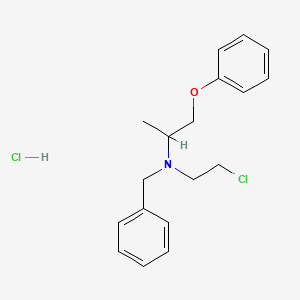D1052 | phenoxybenzamine hydrochloride
| Toxicity | Dose | Time | Species | Model | Method | Action | Positive criterion | Reference |
|---|---|---|---|---|---|---|---|---|
| MEMBRANE POTENTIAL | 48.80±9.17 | human | qHTS-HepG2 | MMP assay | decrease | IC50 | 163 | |
| MEMBRANE POTENTIAL | 35.48 | human | HepG2 | MMP assay | decrease | IC50 | 163 | |
| MEMBRANE POTENTIAL | rat | hepatocytes | MMP assay | Negative | IC50 | 163 | ||
| Pictogram | Signal | Statements | Precautionary Statement Codes |
|---|---|---|---|
  |
Warning |
Aggregated GHS information provided by 40 companies from 1 notifications to the ECHA C&L Inventory. Each notification may be associated with multiple companies. H302 (100%): Harmful if swallowed [Warning Acute toxicity, oral] H351 (100%): Suspected of causing cancer [Warning Carcinogenicity] Information may vary between notifications depending on impurities, additives, and other factors. The percentage value in parenthesis indicates the notified classification ratio from companies that provide hazard codes. Only hazard codes with percentage values above 10% are shown. |
P201, P202, P264, P270, P281, P301+P312, P308+P313, P330, P405, and P501; (The corresponding statement to each P-code can be found at the GHS Classification page.) |
  |
Danger |
H303: May be harmful if swallowed [Warning Acute toxicity, oral] H317: May cause an allergic skin reaction [Warning Sensitization, Skin] H351: Suspected of causing cancer [Warning Carcinogenicity] H370: Causes damage to organs [Danger Specific target organ toxicity, single exposure] |
P201, P202, P260, P261, P264, P270, P272, P280, P281, P302+P352, P307+P311, P308+P313, P312, P321, P333+P313, P363, P405, and P501; (The corresponding statement to each P-code can be found at the GHS Classification page.) |
| Organism | Test type | Route | Dose (normalized dose) | Effect | Source |
|---|---|---|---|---|---|
| rat | LDLo | oral | 800mg/kg (800mg/kg) | Journal of Pharmacology and Experimental Therapeutics. Vol. 110, Pg. 463, 1954. | |
| man | TDLo | oral | 7143ug/kg/5D- (7.143mg/kg) | kidney, ureter, and bladder: "changes in tubules (including acute renal failure, acute tubular necrosis)" | Annals of Internal Medicine. Vol. 107, Pg. 119, 1987. |
| mouse | LD50 | subcutaneous | 105mg/kg (105mg/kg) | Arzneimittel-Forschung. Drug Research. Vol. 17, Pg. 305, 1967. | |
| mouse | LD50 | intraperitoneal | 99mg/kg (99mg/kg) | Gazzetta Chimica Italiana. Vol. 92, Pg. 3, 1962. | |
| mouse | LD50 | intravenous | 63750ug/kg (63.75mg/kg) | European Journal of Pharmacology. Vol. 9, Pg. 289, 1970. | |
| mouse | LD50 | oral | 900mg/kg (900mg/kg) | Archives Internationales de Pharmacodynamie et de Therapie. Vol. 108, Pg. 102, 1956. | |
| (R)-Phenoxybenzamine Hydrochloride | 055P152 | 2-(N-Benzyl-2-chloroethylamino)-1-phenoxypropane hydrochloride |
| 63-92-3 | AB0013102 | AB2000604 |
| AC-8077 | AI3-52044 | AK-64371 |
| AKOS015966790 | ANW-45430 | AOB5790 |
| AS-16927 | B-019 | BCP28467 |
| Bensylyt NEN | Bensylyte HCl | Benzenemethanamine, N-(2-chloroethyl)-N-(1-methyl-2-phenoxyethyl)-, hydrochloride |
| Benzenemethanamine, N-(2-chloroethyl)-N-(1-methyl-2-phenoxyethyl)-,hydrochloride | Benzyl(2-chloroethyl)(1-methyl-2-phenoxyethyl)amine hydrochloride | Benzylamine, N-(2-chloroethyl)-N-(1-methyl-2-phenoxyethyl)-, hydrochloride |
| C07436 | C18H23Cl2NO | CAS-63-92-3 |
| CCG-39614 | CCRIS 506 | CHEBI:8078 |
| CHEMBL1200787 | CPD000058422 | CS-2537 |
| CTK6H8164 | Certified Reference Material; | D00507 |
| D0158 | DB-054579 | DSSTox_CID_1127 |
| DSSTox_GSID_21127 | DSSTox_RID_75958 | DTXSID0021127 |
| Dibenzylene | Dibenzyline | Dibenzyline (TN) |
| Dibenzyline chloride | Dibenzyline hyd rochloride | Dibenzyline hydrochloride |
| Dibenzyran | EINECS 200-569-7 | EN300-52514 |
| EU-0100235 | FT-0603264 | H533 |
| HMS1570N10 | HY-B0431A | J-009731 |
| LP00235 | LS-1516 | MCULE-2455465785 |
| MFCD00055152 | MLS000069374 | MLS002222313 |
| N-(2-Chloroethyl)-N-(1-methyl-2-phenoxyethyl)-benzylamine Hydrochloride | N-(2-Chloroethyl)-N-(1-methyl-2-phenoxyethyl)benzenemethanamine hydrochloride | N-(2-Chloroethyl)-N-(1-methyl-2-phenoxyethyl)benzylamine hydrochloride |
| N-(2-Chloroethyl)-N-(1-methyl-2-phenoxyethyl)benzylamine, hydrochloride | N-2-Phenoxyisopropyl-N-benzyl-beta-chloroethylamine hydrochloride | N-2-Phenoxyisopropyl-N-benzyl-chloroethylamine hydrochloride |
| N-2-phenoxyisopropyl- N-benzyl-chloroethylamine hydrochloride | N-Benzyl-N-phenoxyisopropyl-beta-chlorethylamine hydrochloride | N-Phenoxyisopropyl-N-benzyl-2-chloroethylamine Hydrochloride |
| N-Phenoxyisopropyl-N-benzyl-beta-chloroethylamine hydrochloride | N-benzyl-N-(2-chloroethyl)-1-phenoxypropan | N-benzyl-N-(2-chloroethyl)-1-phenoxypropan-2-amine hydrochloride |
| N-benzyl-N-(2-chloroethyl)-1-phenoxypropan-2-amine;hydrochloride | NC00598 | NCGC00089748-02 |
| NCGC00089748-06 | NCGC00093699-01 | NCGC00093699-02 |
| NCGC00093699-03 | NCGC00093699-04 | NCGC00256370-01 |
| NCGC00259137-01 | NCI-C01661 | NE47907 |
| NSC 37448 | NSC-37448 | NSC-759572 |
| NSC37448 | NSC759572 | Opera_ID_300 |
| POB HCl | Pharmakon1600-02300176 | Phenoxybenzamine (hydrochloride) |
| Phenoxybenzamine HCl pound>>NCI-C01661 pound>> NCI C01661 pound>> NCIC01661 pound>>NSC 37448 pound>>NSC37448 pound>>NSC-37448 | Phenoxybenzamine Hcl | Phenoxybenzamine Hydrochloride, Pharmaceutical Secondary Standard |
| Phenoxybenzamine Hydrochloride,(S) | Phenoxybenzamine chloride | Phenoxybenzamine hydrochloride |
| Phenoxybenzamine hydrochloride (USP) | Phenoxybenzamine hydrochloride [USAN] | Phenoxybenzamine hydrochloride, >=97%, powder |
| Phenoxybenzamine hydrochloride, United States Pharmacopeia (USP) Reference Standard | Phenoxybenzamine.HCl | Phenyoxybenzamine hydrochloride |
| Q27107723 | RT-000645 | S2499 |
| SAM002548984 | SAM002564244 | SCHEMBL50729 |
| SMR000058422 | SPECTRUM2300176 | SR-01000000017 |
| SR-01000000017-2 | SR-01000000017-6 | ST2407428 |
| SW197327-3 | Tox21_201588 | Tox21_302978 |
| WLN: G2N1R&Y1&1OR &GH | benzyl(2-chloroethyl)(1-phenoxypropan-2-yl)amine hydrochloride | fenoxybenzamin |
| phenoxybenzamide hydrochloride | phenoxybenzamine-hydrochloride |

